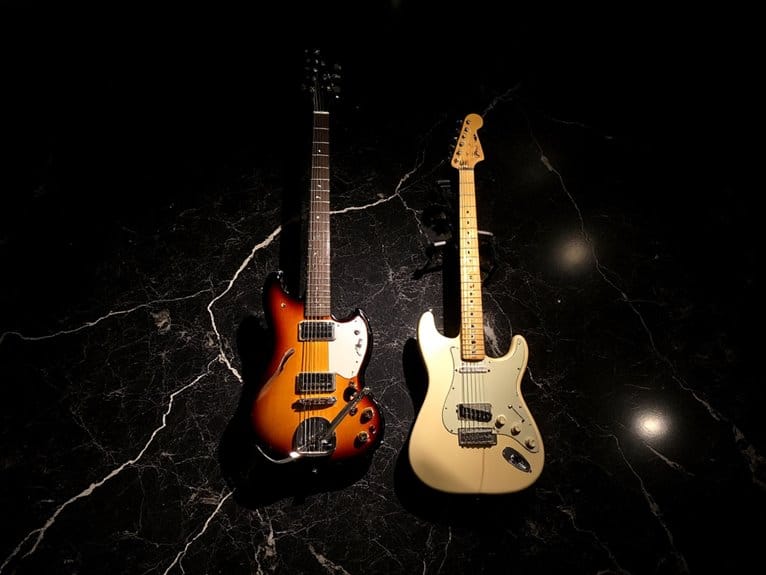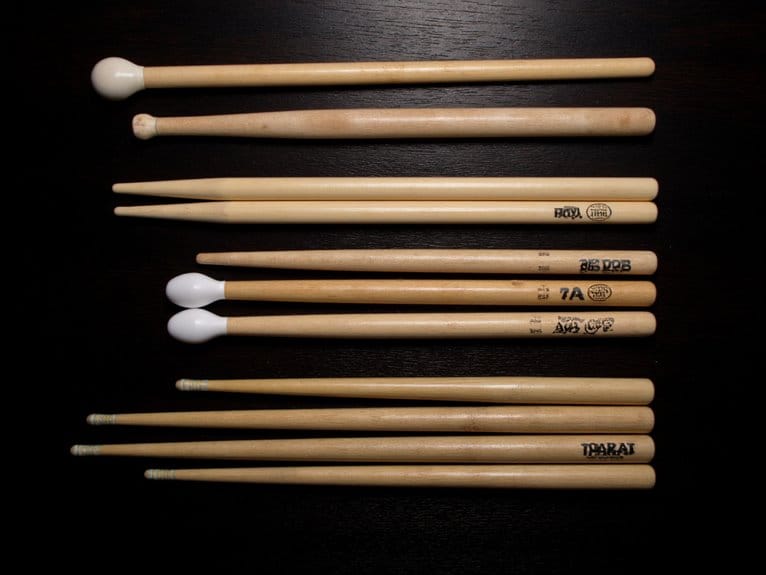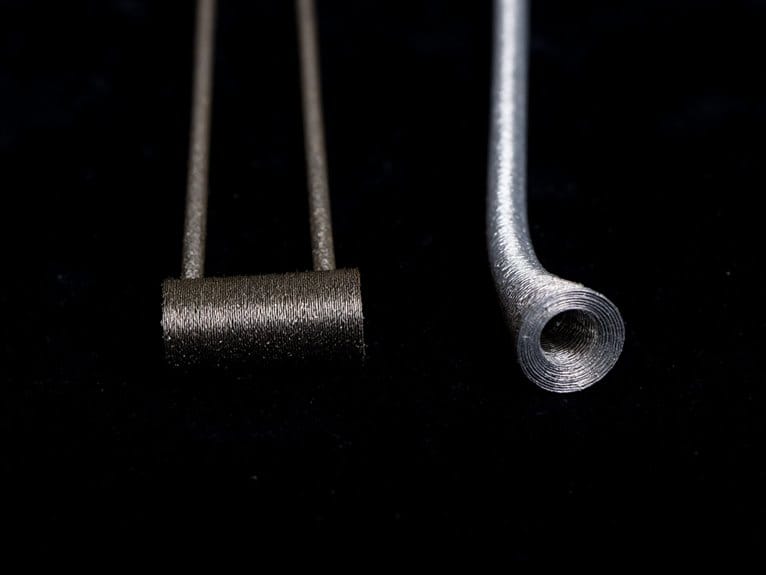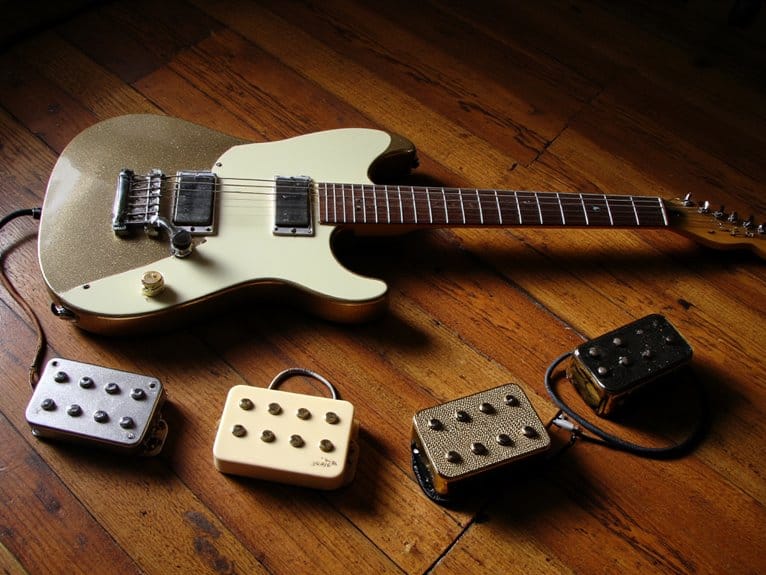Guitar Scale Length: How It Affects Tone and Feel
Your guitar’s scale length—that vital measurement from nut to bridge saddle—directly controls string tension, which shapes both playability and tone. Shorter scales like Gibson’s 24.75″ create warmer, midrange-heavy sounds with easier bending, while Fender’s 25.5″ produces brighter tones with increased tension that suits cutting through dense mixes. I’ve found that even a half-inch difference noticeably affects finger fatigue and fret spacing, making scale length selection essential for your playing style and musical preferences, though there’s much more beneath these fundamentals.
We are supported by our audience. When you purchase through links on our site, we may earn an affiliate commission, at no extra cost for you. Learn more.
Notable Insights
- Shorter scales (24.75″) produce warmer, thicker tones while longer scales (25.5″) generate brighter sounds with more high-frequency content.
- Scale length directly affects string tension, with longer scales requiring higher tension that can increase finger fatigue during play.
- Longer scales create wider fret spacing, making finger stretches more challenging but potentially improving intonation and note clarity.
- String gauge adjustments can compensate for scale differences—lighter strings for longer scales, heavier strings for shorter scales.
- Extended scales (26-30″) are preferred for metal genres and lower tunings due to improved string clarity and tension.
Understanding Scale Length Fundamentals
Scale length represents one of those fundamental guitar specifications that many players overlook, yet it’s quietly shaping every note you play.
Simply put, scale length measures the vibrating string distance between your guitar’s nut and bridge saddle, though I’ve found the most accurate measurement involves doubling the distance from nut to the 12th fret center.
This fundamental importance becomes clear when you consider that most electric guitars cluster around two standards: Gibson’s 24.75-inch length and Fender’s 25.5-inch measurement.
While these differences might seem minimal, they’re actually creating distinct tonal signatures that define entire categories of instruments, influencing everything from harmonic content to sustain characteristics in ways that affect your playing experience. The scale length also determines string tension levels, which directly impacts how your strings respond to bending and overall playability comfort.
Bass guitars operate on completely different scale standards, with short scale basses at 30 inches, medium at 32 inches, long at 34 inches, and extra-long configurations reaching 36 inches.
String Tension and Playability Dynamics
When you press down on a string, you’re experiencing the direct result of physics at work, and honestly, I’ve spent more time than I’d like to admit thinking about why some guitars feel like butter under my fingers while others require what feels like superhuman strength to bend a note.
Some guitars feel like butter under your fingers while others demand superhuman strength to bend a single note.
Scale length greatly affects string tension, which directly impacts how your guitar responds to your touch. Here’s what you need to know:
- Longer scales create higher tension – A 27-inch scale produces considerably more string tension than a 25.5-inch scale when using identical strings and tuning.
- Tension adjustment through gauge selection – You can compensate by choosing lighter strings for longer scales or heavier gauges for shorter scales. A half gauge difference compensates for 1-1.5 inch difference in scale length, making this adjustment process surprisingly predictable. Professional guitarists often use 48KHz sampling rates when recording to accurately capture the subtle tonal differences that various string tensions produce across different scale lengths.
- Playability differences are measurable – Tension variations of 10-11% between scale lengths affect bending ease and finger fatigue noticeably. String tension differences become especially apparent when using effects pedals that emphasize tonal nuances, as the enhanced signal processing reveals subtle variations in how strings respond to fretting pressure and bending techniques.
Tonal Characteristics Across Different Scale Lengths
When you’re comparing guitars across different scale lengths, you’ll immediately notice how shorter scales like Gibson’s 24.75″ produce that signature warm, thick tone that emphasizes midrange frequencies and creates a creamy sound texture.
Conversely, longer scale lengths such as Fender’s 25.5″ generate brighter, more cutting tones with pronounced high-frequency response and stronger upper harmonics that make notes sparkle with clarity.
This fundamental difference in tonal character stems from how scale length affects string tension, which directly influences the harmonic content and overall voice of your instrument.
Many affordable electric guitars feature quality materials like Canadian maple necks that help maintain consistent tonal characteristics regardless of their scale length configuration.
Short Scale Warmth
I’ve spent countless hours comparing guitars with different scale lengths, and there’s something undeniably magical about the warm, enveloping tone that emerges from shorter scales—typically those measuring 24.75 inches or less from nut to bridge saddle. The reduced string tension creates this wonderfully thick, harmonically rich sound that’s perfect for rhythm playing and vocal accompaniment.
Key short scale advantages include:
- Lower string tension makes bending and fretting considerably easier, reducing physical strain during extended playing sessions.
- Warmer midrange focus delivers that coveted vintage tone with softer attack characteristics that many players desperately seek.
- Enhanced playability accommodates smaller hands and complex chord voicings with closer fret spacing.
However, short scale drawbacks involve potentially muddier bass response and less note definition compared to longer scales, though many players actually prefer this rounded tonal balance. While shorter scales may sacrifice tonal clarity for comfort, the scale length fundamentally affects string tension and overall instrument response across all playing styles. For players with smaller hands, shorter scale lengths between 23-25 inches significantly reduce finger stretching requirements, making complex chord progressions more accessible and comfortable to execute. The Ibanez AG75G features a 25.5-inch scale length that demonstrates how scale variations influence both tonal characteristics and player comfort across different hollow body guitar designs.
Long Scale Brightness
While short scales deliver that cozy, vintage warmth, longer scale guitars—those measuring 25.5 inches like Fender’s iconic designs, or even the extended 26-28 inch scales found on modern seven and eight-string instruments—produce an entirely different sonic character that’s defined by crystalline clarity and pronounced brightness. The increased string tension creates that distinctive “snap” you’ve heard countless times, where each note cuts through a mix with bell-like precision and enhanced harmonic clarity.
| Scale Length | Tonal Character | Notable Examples |
|---|---|---|
| 25.5″ | Bright, snappy, bell-like | Fender Strat/Tele |
| 26″-28″ | Ultra-clear, defined bass | Extended range guitars |
This bright tone comes from how longer scales position harmonics along the string, creating more pronounced overtones that enhance note articulation and separation—perfect for genres demanding crisp definition. When paired with the right amplifier, these clean tone qualities become even more pronounced, as the amp’s frequency response and circuitry design help capture the full tonal nuances that longer scale guitars naturally produce. For acoustic-electric guitars, 80/20 bronze strings can further enhance this brightness characteristic, as their copper-zinc composition naturally emphasizes the crisp, punchy tones that complement longer scale instruments.
Common Scale Length Standards and Variations
When you’re shopping for a guitar, you’ll quickly discover that manufacturers haven’t exactly agreed on a universal scale length standard, though certain measurements have become deeply entrenched in the industry through decades of player preference and tonal tradition.
The big players like Fender and Gibson fundamentally created their own standards—25.5 inches and 24.75 inches respectively—which now serve as reference points that countless other manufacturers either adopt directly or use as starting points for their own variations.
Understanding these common measurements, and why companies choose to deviate from them, will help you predict how a guitar might feel and sound before you even pick it up. Popular models like the Fender Squier Stratocaster maintain the classic 25.5-inch scale length while offering budget-friendly access to this traditional specification.
Fender’s 25.5-inch scale length creates tighter string tension, which contributes to the bright, crisp tone characteristic of Telecaster models and affects both the guitar’s sustain and overall playing feel. Many specialty guitars like Flying V guitars incorporate these standard scale lengths to maintain their powerful sound characteristics while delivering their distinctive bold aesthetic.
Industry Standard Measurements
Two primary scale length standards dominate the guitar industry, with most electric guitars clustering around either 24.75 inches (Gibson style) or 25.5 inches (Fender style).
Acoustic guitars typically measure between 25.4 and 25.5 inches for what manufacturers consider the sweet spot of balanced tone and string tension.
Classical guitars follow their own conventions, with 650mm (25.6 inches) serving as the international standard, though you’ll find variations ranging from 640mm to 665mm depending on the maker’s philosophy and scale length history.
The industry maintains measurement consistency through a specific method:
- Measure from nut to 12th fret center, then double the distance
- Avoid direct nut-to-saddle measurements due to intonation compensation
- Use imperial measurements primarily, converting to metric for international markets
Different scale lengths significantly impact string tension and playability, with shorter scales like the 24.75-inch standard requiring less finger pressure and offering easier bending for extended practice sessions.
Manufacturer Design Choices
Although the industry has settled on two dominant scale lengths, I’ve found that major manufacturers actually employ surprisingly diverse approaches to scale length selection, each reflecting their unique design philosophies and target markets.
Gibson’s historical evolution shows fascinating design flexibility, shifting between 24 9/16″ and 24 5/8″ across different eras while creating specialized models like the 23.5″ Byrdland for specific player preferences.
Fender demonstrates similar tonal innovation, ranging from the 22.5″ DuoSonic to 27″ baritone models, each serving distinct manufacturer intent.
PRS exemplifies modern thinking with their 25″ compromise scale, strategically positioned between Gibson’s warmth and Fender’s brightness to achieve their signature sound that appeals to players seeking balanced characteristics.
Physical Comfort and Playing Technique Considerations
The relationship between scale length and physical comfort represents one of the most overlooked aspects of guitar selection, yet it’s something I’ve found dramatically affects how long you can play without fatigue and how easily you’ll execute complex techniques.
Longer scales create higher string tension at identical pitches, which means you’ll press harder to fret notes and bend strings, leading to increased hand fatigue during extended sessions.
Meanwhile, wider fret spacing challenges your finger stretch capabilities, particularly when reaching complex chord voicings or maneuvering wide intervals.
Key comfort considerations include:
- String tension differences – Shorter scales reduce finger strain and make bending techniques more accessible.
- Fret spacing variations – Closer frets on shorter scales accommodate smaller hands and shorter fingers.
- Setup adjustments – Lighter strings and optimized action can mitigate longer scale challenges.
Genre Applications and Musical Style Matching
Four decades of playing across diverse musical genres have taught me that scale length isn’t just a technical specification—it’s fundamentally a sonic fingerprint that can make or break your sound within specific musical contexts.
Your genre compatibility largely depends on understanding how different scale lengths serve particular musical demands, while style influence becomes apparent when you match the right specifications to your artistic vision.
For rock and pop, you’ll find that Fender’s 25.5″ scale delivers the bright, defined attack that cuts through dense mixes, whereas Gibson’s 24.75″ scale offers the warmer, mellower tones perfect for blues-influenced ballads. Just as guitarists consider tube amplifiers for their warm, rich tones that complement these scale length characteristics, the synergy between your guitar’s specifications and amplification choices becomes crucial for achieving professional results.
Metal and progressive players gravitate toward extended scales—26″ to 30″—because the increased string tension maintains clarity in lower tunings and provides the aggressive attack that heavy music demands. Professional guitarists often record through audio interfaces that capture every tonal nuance with 24-bit resolution to preserve the dynamic range and detail that different scale lengths provide.
Similarly, vocalists recording with dynamic microphones understand that achieving professional results requires careful attention to technical specifications, as high-gain preamps deliver the clean amplification needed to capture subtle tonal nuances that define different musical styles.
Frequently Asked Questions
How Does Scale Length Affect String Life and Breakage Rates?
Longer scales increase string tension, causing higher breakage rates and shorter string life. You’ll experience more snapping with aggressive playing, but gain improved tonal sustain. Shorter scales reduce tension, extending string durability considerably.
What Maintenance Differences Exist Between Short and Long Scale Guitars?
You’ll find short-scale guitars need more frequent string changes due to lower tension, while long-scale instruments require heavier string gauge adjustments and show increased fret wear from higher tension and wider stretches.
On a final note
You’ll find that scale length isn’t just a technical specification—it’s the foundation that shapes your entire playing experience, from the tension under your fingers to the frequencies that reach your audience’s ears. Whether you’re drawn to the snappy attack of a 25.5″ Fender or the warm sustain of a 24.75″ Gibson, understanding these differences helps you make informed decisions that align with your musical goals and physical comfort.







